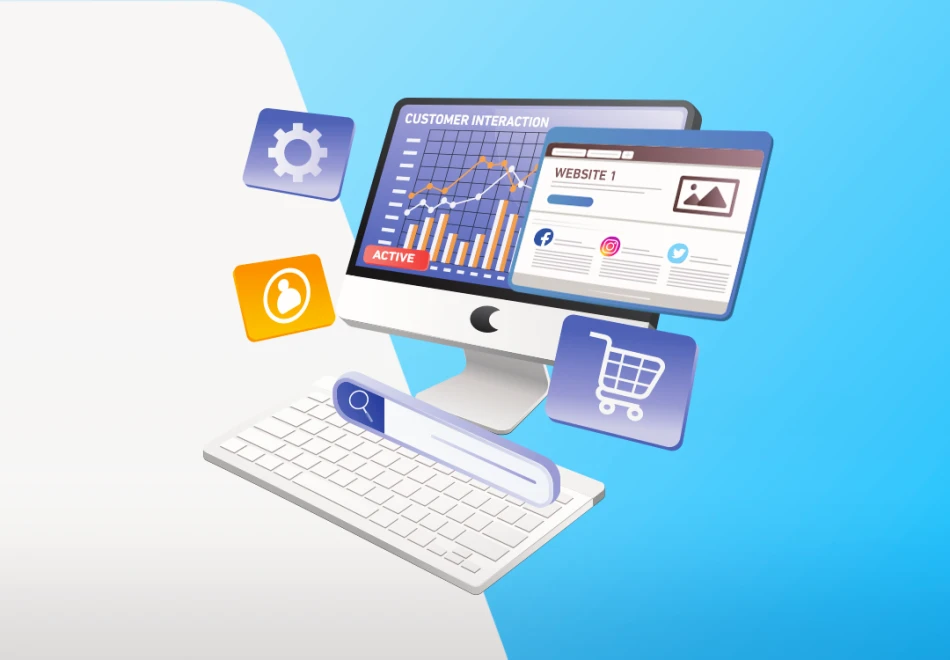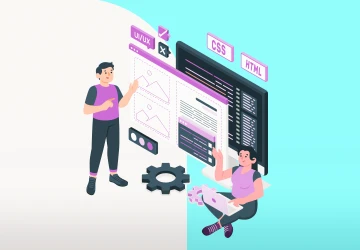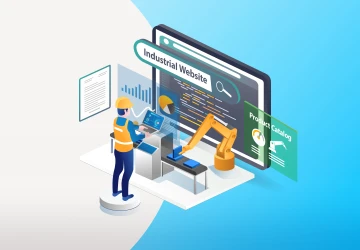Online Presence for Business Growth: How to Stay Ahead of the Competition

In today’s digital world, having a solid online presence for business isn’t just nice to have—it’s a must.
Think about it: billions of people are searching, shopping, and connecting online every day.
If your business isn’t easy to find, you’re missing out on huge opportunities.
Your online presence for business is what helps your audience discover you and interact with your brand.
That’s why I’ve made it my goal to uncover simple, effective ways to improve your online presence for business, increase your business website visibility, and create strong digital branding that makes your business stand out.
In this article, I’ll share practical steps to help you strengthen your online presence for business, so you can reach more people and build lasting connections with your audience.
What Does Online Presence Mean?
An online presence for business is all about how easy it is for people to find your brand online.
Think of it as setting up shop not just on a busy street, but everywhere online—from your website and social media platforms to popping up in search results or online directories.
That’s where digital branding steps in.
It's all about crafting an image and a vibe for your business that sticks with people.
Now, when someone’s hunting for your products or services, how visible your website is—business website visibility—can make or break whether they click on you or someone else.
How to Enhance Your Online Presence?
a. Foundation Steps
1. Create a Professional Website
Your website is the heart of your online presence for business.
It’s where customers go to learn about you, trust your brand, and connect with what you offer.
It’s also where you can directly address your customers’ needs, providing solutions that help you stand out.
To make your website effective and boost your business website visibility, choose a platform that’s easy to use and customize.
Tools like Alweb, Wix, WordPress, and Squarespace are popular choices because they offer drag-and-drop builders and pre-designed templates.
For example, Alweb CMS gives you built-in analytics and marketing tools to make your website not only look great but also work smoothly.
2. Grow an Email Subscriber List
An email list helps you stay connected with your audience—whether they’re loyal customers or potential ones—by sending them updates, special offers, or valuable tips.
To grow your email list and improve your business website visibility, start by offering something valuable, like free guides or resources.
These can be gated content, meaning people need to sign up with their email to access it.
This not only helps you collect email addresses but also shows that your audience finds value in what you offer.
Adding clear, engaging calls-to-action (CTAs) to your website and social media pages can make it even easier for people to subscribe to your newsletter.
The good news is, that tools like HubSpot’s free CMS, MailChimp, and GetResponse make the whole process simple.
These platforms offer features like pop-up forms, slide-ins, and email builders to help you create and manage email campaigns with ease.
This way, you can seamlessly add sign-up forms to your site and keep your audience engaged without much extra effort.
3. Establish a Strong Social Media Presence
With over 3.2 billion people hooked on social media around the world, these platforms are key to expanding your online presence for business.
Think about it: social media is where your audience is already hanging out.
It’s perfect for building trust, sparking connections, and fostering long-lasting relationships.
Plus, it’s an awesome way to get more eyes on your business website by driving traffic and boosting engagement.
When someone’s curious about your business, chances are they’ll head straight to your social media to see what’s up.
They’ll check out your posts and notice how others interact with you.
If they find your pages quiet or outdated, they might wonder if you’re still in business or if you’re serious about your services.
And, of course, that’s the last thing you want!
Social media is also crucial for your digital branding.
It’s where your brand’s personality shines and your voice gets heard.
Whether you're updating followers, sharing tips, or answering questions, platforms like Instagram, Facebook, LinkedIn, and X are where you can connect genuinely with people.
b. Content Creation and Engagement
4. Consistently Publish High-Quality Content
Our goal is simple: keep your customers interested and coming back for more.
One of the best ways to do this is by consistently creating high-quality content.
The more content you put out, the more chances you have to grow your online presence for business.
It’s about showing up in all the right places—whether that’s on Google, social media, or platforms like YouTube—and connecting with your audience where they already are.
You can start by figuring out where your audience spends their time.
Are they scrolling through Instagram and Facebook? Watching videos on YouTube? Or browsing niche platforms like Etsy or Goodreads?
Once you know where they hang out, create content tailored for those spaces.
For example, if your audience loves YouTube, focus on creating videos that educate or entertain them.
If Instagram is their favorite, post eye-catching photos with captions that reflect your brand’s personality.
Each platform is unique, so make sure your content feels natural and relevant wherever it’s posted.
5. Optimize for Search Engines (SEO)
Search Engine Optimization (SEO) is about making your website easy to find when people search online for products or services you offer.
It’s a key part of building your online presence for business.
Simply put, better SEO means your site ranks higher on search engines like Google, bringing more visitors to your website and increasing your visibility.
SEO is also crucial for boosting your business website visibility and enhancing your digital branding.
It ensures your business appears credible and trustworthy while providing valuable content that your audience wants.
SEO has two main parts:
On-site SEO: This is all about what happens on your website.
Keyword Research: Find out what your audience is searching for and use those keywords naturally in your content.
Content Quality: Create helpful, relevant content that answers your audience’s questions.
Internal Linking: Link pages within your website to make navigation easier and keep visitors exploring.
Meta Tags Optimization: Write clear and engaging titles and descriptions to encourage people to click on your site from search results.
Off-site SEO: This focuses on improving your website’s reputation and authority from outside sources.
Backlink Building: Get links from trusted websites to show search engines your site is reliable.
Social Media Engagement: Share your content on platforms like Instagram or Facebook to reach more people and drive traffic to your site.
Guest Blogging: Write articles for other websites to introduce your brand to new audiences and gain valuable backlinks.
To get the most out of SEO, use tools like Google Keyword Planner to find the best keywords for your audience.
Regularly audit your website to fix any technical issues that might hold you back.
Also, setting up a Google My Business account helps you appear in local search results, making it easier for nearby customers to find you.
6. Deliver Valuable Insights and Resources
To truly succeed, your brand needs to focus on giving value to your audience before asking for their business.
One of the easiest and most effective ways to do this is by sharing free, educational content online.
Not only does this help your customers, but it also boosts your online presence for business by showing people that you’re a reliable and helpful resource.
You can start by understanding what your audience needs.
What are their biggest challenges? What questions do they have?
Take a look at your buyer persona—the profile of your ideal customer—and use it to brainstorm content ideas.
You can also add value by offering advice in other ways.
Write guest posts for well-known websites, reply to questions or comments on social media, or share your knowledge on a podcast.
The idea is to meet your audience wherever they are, providing answers and guidance when they need it most.
7. Stay Actively Engaged Online
Since you’ve taken your business online, remember this: if you don’t stay engaged, you're letting your efforts disappear into thin air.
It’s not enough to just have a website or some social media accounts; you've got to dive in and keep those platforms buzzing with activity.
Regular updates and cool, fresh content show the world that your brand isn’t just hanging around—it’s lively, active, and ready to interact.
Here's the scoop: being online is way more than just throwing up posts.
It’s about forging real, meaningful connections.
When someone drops a comment on your post or sends a direct message, hitting them back quickly is key.
Even though these might seem like small gestures, they're powerful in building trust and making those lasting connections that keep people coming back.
And don't just stick to your stuff.
Get involved in the wider conversations happening in your field, especially the hot topics that everyone's buzzing about.
Chime in with your insights, dish out advice, or toss in a fresh angle.
8. Meet Your Audience Where They Are
Back in the day, promoting your products or services meant putting up billboards, placing ads in newspapers, or running TV commercials, and hoping your audience would notice.
But it was a gamble—most of the time, you’d end up reaching people who weren’t interested.
Now, with the internet, you can skip the guesswork and go straight to where your audience is already spending their time.
To build a strong online presence for business, you need to focus on the platforms your customers use.
If your audience is scrolling through Instagram but ignoring Twitter, there’s no point in pouring your energy into the wrong platform.
Instead, tailor your efforts.
For example, on Instagram, post vibrant photos, engaging stories, or fun reels.
If Facebook is where they hang out, create meaningful updates, join discussions in groups, and interact with your followers.
9. Add Personality to Your Brand
Building your online presence for business isn’t just about being seen—it’s about being remembered.
A great way to do this is by giving your brand its unique personality.
I like to think of a brand as a person with a distinct character that people can connect with.
Take Wendy’s, for example.
The fast-food chain doesn’t just talk about burgers—they’ve created a fun, witty, and sometimes sarcastic personality, especially on social media.
Their tweets are filled with humor and cultural references that keep people engaged.
This playful approach makes their brand memorable and creates a deeper emotional connection with their audience.
Now think about your brand.
If it were a person, what kind of personality would it have? Would it be friendly and professional? Quirky and creative? Calm and reliable?
Defining this personality helps you connect with your target audience in a way that feels genuine.
It also shapes your tone, messaging, and how you interact with customers, from social media posts to email newsletters.
c. Expansion and Optimization
10. Track and Evaluate Your Performance
Sometimes, building your online presence for business can feel like you're just tossing ideas out there and seeing what sticks.
That's exactly why it's so crucial to track and evaluate how things are going.
This isn't just about ticking boxes; it's about figuring out what's hitting the mark and what's missing.
First things first, define what success looks like for you.
Are you working on boosting your SEO?
Then you'll want to keep tabs on things like your search engine rankings and how much traffic you're pulling in from Google.
Or maybe you’re focused on beefing up your email list?
In that case, watch how many new subscribers you're getting and how engaged they are with the emails you send out.
These metrics help see if you're connecting with your audience.
But, keep in mind that some things take a while to cook.
Improvements in SEO and building up your brand awareness aren't going to show overnight.
But don't sweat it—these are long games.
For the less obvious wins like brand awareness, look for signs like more visits to your website, more chit-chat on social media, or even positive vibes from customer feedback.
Also, don’t forget to mix things up with some testing.
Play around with different tactics, whether that's shaking up how you do your content, trying new keywords, or tweaking how you chat with your audience.
Testing out new approaches will help you nail down what works best and resonates with your folks.
11. Build Meaningful Relationships
Relationships matter—not just in life, but also for growing your online presence for business.
For example, teaming up with bloggers, podcasters, or influencers in your field can open up exciting opportunities.
You could land a guest post on their blog, be invited to join a podcast episode or get a shoutout that introduces your brand to a whole new audience.
These partnerships aren’t just about self-promotion—they’re about building a community.
When you collaborate with others, you show that you’re not just in it for yourself; you’re genuinely invested in your industry.
This authenticity strengthens your digital branding and helps people see your business as relatable and trustworthy.
The benefits don’t stop there.
When others feature or endorse you, it boosts your business website visibility.
More people will find your website, check out your content, and engage with your brand.
Every new connection adds to your reach, like building a web of opportunities that keeps growing.
12. Explore New Platforms and Communities
The digital world moves fast, and staying ahead means being willing to try out new platforms and join fresh communities.
Exploring these spaces early is the best way to grow your online presence for business and connect with audiences in exciting ways.
When a new social media platform or website gains popularity, being one of the first to join can give you a big advantage.
Why?
Because there’s less competition at the start.
Fewer brands are trying to grab attention, so your content has a much better chance of standing out.
Plus, new platforms often have high engagement rates because users are curious and eager to interact.
It’s the perfect time to introduce your brand and make a memorable impression.
To stay ahead of the curve, make a habit of keeping an eye on industry news and trends.
Look for up-and-coming platforms or niche communities where your audience might hang out.
But this isn’t just about jumping on the latest trend—it’s about meeting your audience where they are and staying visible as the digital landscape changes.
13. Streamline Your Workflow with Automation
When your brand starts to grow and things get busier, managing your online presence for business can feel like an uphill battle.
Social media posts, email campaigns, and website updates can quickly pile up, leaving you scrambling to keep up.
That’s where automation comes in—it’s like having a digital assistant working behind the scenes, tackling repetitive tasks so you can focus on what truly matters.
Automation makes staying consistent so much easier.
Tools like Hootsuite or Buffer let you schedule social media posts and blog updates in advance.
It’s a simple way to ensure your digital branding remains sharp and your business website visibility is steady.
Email marketing is another area where automation works wonders.
You can set up newsletters to send automatically, keeping your audience updated without lifting a finger.
Add sign-up forms to your website, and you’ll grow your email list effortlessly.
These automated systems not only save time but also keep your relationships with customers alive and thriving.
Even content curation becomes a breeze.
Instead of constantly creating fresh content, automation tools help you find and share useful resources from your industry.
d. Advanced Strategies
14. Showcase Your Products on Online Marketplaces
Expanding your online presence for business isn’t just about running a great website—it’s about being where your customers already shop.
For many people, platforms like Amazon, eBay, Google Shopping, Alibaba, and Etsy are the first places they look when searching for products.
Listing your items on these mega-markets is like setting up shop in a busy mall—it puts your brand in front of a huge, ready-to-buy audience.
These platforms don’t just bring more eyes to your products; they also boost your digital branding.
Shoppers trust well-known marketplaces, and when your products are listed there, your business benefits from that built-in credibility.
It’s a great way to introduce your brand to new customers who might not stumble upon your website otherwise.
Here’s a smart move: include a link to your website in your product descriptions.
When customers are happy with their purchase, they’re more likely to visit your site directly next time.
This helps you avoid marketplace fees while creating a stronger connection with your customers.
15. Get Listed in Reputable Online Directories
Online directories are like the modern version of phone books.
They organize businesses into categories so customers can easily find what they’re looking for.
These directories display your business name, address, contact details, and services, making them a great tool for increasing your online presence for business—especially for local searches.
Start by claiming your Google My Business (GMB) listing.
It’s free and one of the easiest ways to improve your visibility in local search results.
Add a short, engaging description of your business, include your contact details, and link to your website so people can find more information about you in just a click.
Once your GMB is set up, explore other directories that are relevant to your region or industry.
For example, if you’re in Europe, check out platforms like Yelp, Europages, Eurobizonline, and the UK Small Business Directory.
These platforms not only expand your reach but also improve your local SEO, making your business more discoverable.
Here’s a pro tip: Always make sure your information is accurate and consistent across all directories.
Double-check that your address, phone number, and website URL match perfectly on every platform.
Inconsistent details can confuse customers and even hurt your search rankings.
16. Strengthen Your Reputation with Positive Reviews
In today’s digital world, your reputation can make or break your business.
Online reviews are one of the most powerful tools to build your online presence for business.
Studies show that about 95% of people check reviews before making a purchase.
They’re like modern-day word-of-mouth, helping potential customers decide if they can trust your products or services.
Fresh reviews matter even more.
Many customers look for feedback from the past month because it shows the current quality of your offerings and customer service.
This means keeping a steady stream of recent, positive reviews is key to staying trustworthy and relevant.
You can start by asking satisfied customers to share their experiences.
Encourage them to leave testimonials or ratings on your website, but don’t stop there—ask them to leave reviews on platforms like Google Reviews, Yelp, or Trustpilot.
These sites are highly trusted and can significantly boost your business website visibility, especially in local search results.
And here’s my secret to making reviews work even better: engagement.
Don’t just sit back and read them—respond!
Thank customers for positive reviews and handle complaints with patience and professionalism.
17. Contribute Guest Posts to High-Authority Websites
Writing guest posts means you get to share your articles or blog posts on other people's websites.
It's a great way to spread the word about what you do and grow your online presence for business.
This not only gets your name out there but also links back to your own site, which can seriously bump up your visibility online.
When you write a guest post for a site that’s well-respected and has loads of followers, you’re getting a spotlight moment.
People who might never have stumbled across your brand get to see what you’re all about.
Plus, you usually get to include backlinks to your website.
This helps shoot your site up the search engine ranks and makes it easier for more people to find you.
Here’s how you can start:
Scout for the Right Spots: Look around for popular blogs or websites that fit your niche and attract the kind of readers you want. If you’re all about fitness, for example, target blogs that talk about health and wellness.
Pitch Your Ideas: Once you’ve found a good spot, pitch them some ideas that you think their readers would dig. Keep your pitches straightforward and on-point. Sometimes you can post for free, and other times you might have to pay a bit (that’s when it’s called a “sponsored article”).
Craft Great Content: When you get the green light, write something awesome that fits the style of the site you’re writing for.
To hit it out of the park, try to score backlinks from mega-authority sites like major news outlets or universities (those with .edu or .gov domains).
You can do this by coming up with original research or insights that are so good these places would want to share them.
18. Create a Wikipedia Page for Your Brand
A Wikipedia page is like a stamp of credibility for your business.
It’s a way to strengthen your online presence for business, build trust, and show that your brand is worthy of attention.
When people see your business featured on Wikipedia, it sends a strong signal of authority and professionalism.
To get started, first, create an account on Wikipedia—it’s free and easy.
Then, draft a page about your brand that tells your story in an honest, factual way.
Share the key details: when your company started, what you’ve achieved, and any unique contributions to your industry.
You need also to keep the tone neutral and avoid turning it into a sales pitch.
The secret to getting your page approved is citing reliable sources.
These should be articles from respected news outlets, published interviews, or research papers that mention your business.
Don’t rely on your website or promotional content—Wikipedia wants independent, verifiable references.
Adding strong sources shows that your business is recognized and respected by others.
Be transparent.
If your company has faced challenges or controversies, address them briefly but honestly.
Show how you’ve handled these situations and the steps you’ve taken to improve.
This builds credibility and prevents others from controlling the narrative with one-sided information.
e. Marketing and Advertising Strategies
19. Partner with Influencers for Greater Reach
Teaming up with influencers is a great strategy to amp up your online presence for business.
These influencers are not just popular figures; they've got dedicated followers who trust their recommendations.
This means when they talk about your brand, their audience listens, making it a fantastic opportunity for you to reach new potential customers in an authentic way.
First up, you need to find the right influencers.
Look for folks whose interests align with what you’re selling.
Say you’ve got a line of eco-friendly skincare products—linking up with influencers who are all about green living can really help push your brand into the spotlight.
Reach out to them with a pitch that highlights what's in it for them and their followers.
Alos, ensure to give these influencers all the tools they need to help promote your brand.
This includes your website link and social media profiles so they can tag you easily.
This way, when they post about your product, their followers can click through to your pages, boosting your business website visibility.
But it’s not just about getting your name out there. Working with influencers also polishes your digital branding.
It shows you’re a trusted name that's connected with key voices in your industry.
20. Test Various Online Advertising Strategies
When we’re shopping for the perfect face cleanser, we don’t just grab the first one we see—we compare, research, and maybe even try a few to find the best fit.
Online advertising is no different.
To grow your online presence for business, you need to experiment with different platforms and strategies to discover what resonates with your audience.
Online ads can give your brand a big boost by putting it in front of the right people.
Search engines like Google, Yahoo, and Bing allow you to run ads that appear right at the top of search results.
Social media platforms like Facebook, Instagram, and YouTube let you target specific groups based on their interests, age, and location.
These tools are your shortcut to improving business website visibility and solidifying your digital branding.
Start by setting a clear goal for your ads.
Are you trying to sell a product, drive people to a special offer, or get more subscribers for your newsletter?
Once you know what you want to promote, figure out where your audience spends their time.
For example, Instagram works great if your audience loves scrolling through photos and short videos, while YouTube is ideal for showcasing longer, engaging content.
The next step is creating an ad that grabs attention.
Use clear, friendly language and a strong call-to-action like “Shop Now” or “Sign Up Today.”
If you’re running ads on search engines, make sure to include keywords your audience is searching for—this helps your ad pop up in relevant searches.
Testing is where you really find what works.
Run a few different versions of your ad with small changes, like tweaking the headline, trying a new image, or testing it on a different platform.
This is called A/B testing, and it’s the best way to see what clicks with your audience.
Keep track of the results and adjust your strategy based on what performs the best.
21. Invest in Paid Advertising Campaigns
Paid advertising is one of the quickest ways to grow your online presence for business by making sure your brand gets in front of the right people.
Unlike organic strategies like SEO or free social media posts, paid ads guarantee visibility and help you connect with potential customers exactly when they’re searching for what you offer.
Platforms like Google, Bing, and Yahoo use a system called pay-per-click (PPC) advertising.
With PPC, you only pay when someone clicks on your ad, so you’re spending money on actual interest rather than just impressions.
For example, with Google Ads, you can target specific keywords that your audience is searching for, so your ad shows up at the top of search results at the perfect time.
Social media platforms like Facebook, Instagram, and YouTube work a bit differently.
Instead of paying per click, you pay for your ad’s reach—how many people see it—and frequency—how often it’s shown.
While paid advertising shouldn’t replace strategies like SEO or content marketing, it’s a good way to get fast results, especially if you’re starting or launching something new. 
f. Boosting Search Visibility
22. Implement Rich Snippets
Rich snippets are those extra bits of information you see in search results—like product prices, customer ratings, and stock availability.
They make your website pop by giving people a quick snapshot of what you offer, without them needing to click on your link first.
It’s like giving searchers a sneak peek that makes them more likely to choose your site.
To set up rich snippets, you’ll use something called schema markup.
It’s like a little map for search engines, helping them find and display the most important details on your page.
For example, on a product page, you can use schema markup to highlight the product name, its price, an image, customer reviews, and whether it’s in stock.
Why is this so useful?
Imagine someone searching for a new coffee maker.
Instead of clicking on every link to compare prices and reviews, they can see all that information right in the search results.
If your page has rich snippets, it instantly grabs their attention and makes them more likely to visit your site, already ready to buy.
23. Target Featured Snippets in Search Results
Featured snippets are those eye-catching answer boxes that show up at the top of Google’s search results.
They give quick, straightforward answers to users’ questions—like a shortcut to the information they’re looking for.
Best of all, getting featured doesn’t cost a thing!
Snagging one of these spots can be a game-changer for your online presence for business, putting your website right where everyone can see it.
To improve your chances of being featured, focus on giving clear and direct answers at the beginning of your content.
Let’s say you’re writing about choosing between red or blue walls for interior design.
A sentence like “Red walls feel warm and inviting, while blue walls are calming and cool” gets straight to the point, making it easy for Google to recognize your content as a perfect match for user questions.
Think about what your audience might type into a search bar.
Questions like “What is the best paint color for small rooms?” or “How does wall color affect mood?” are great starting points.
Be sure to answer these questions in a way that’s simple and easy to understand.
Using bullet points, numbered lists, or short paragraphs can also help, as Google loves content that’s easy to skim.
24. Optimize for Related Search Queries
You’ve probably seen Google’s “People also ask” section when searching for something online.
It’s that handy box with related questions and quick answers, and it’s a goldmine for boosting your online presence for business.
These suggestions aren’t random—they’re driven by Google’s algorithms, which analyze blog post structures, especially the subheadings (H2s).
The trick is simple: turn your H2 subheadings into questions.
If you’re writing about “solar panels for homes,” for example, use subheadings like “How do solar panels work for homes?” or “What are the benefits of solar panels for homeowners?”
Then, make sure each question is followed by a clear, easy-to-understand answer that directly addresses the topic.
Also, including multiple related questions in a single blog post not only boosts your chances of being featured in the “People also ask” section but also makes your content more helpful and engaging for readers.
25. Build a Strong Backlink Profile
Backlinking is when one webpage links to another.
It’s like getting a recommendation—when a website links to your content, it tells search engines, “This page is worth checking out.”
Backlinks are crucial for boosting your online presence for business because they show search engines that your site is trustworthy and valuable.
There are two types of backlinks you should focus on: internal links and external links.
Internal links are the ones you add within your own website to connect related pages.
For example, if you have a blog post about “Best Solar Panels for Homes,” you could link to another article on your site explaining “How Solar Panels Work.”
These links help visitors easily navigate your website while showing search engines how your pages are connected.
External links, or backlinks, come from other websites linking to yours. Think of it as another site vouching for your content.
For instance, if a respected solar energy blog links to your guide on solar panel installation, it tells search engines, “This content is reliable and worth promoting.”
The more quality external links you have, the better your site will rank in search results.
To build a strong backlink profile, start by focusing on quality over quantity.
Look for opportunities to get links from reputable websites in your industry.
You can also create internal links strategically by using anchor text (the clickable part of the link) that clearly describes the target page.
For example, instead of “click here,” use something like “How Solar Panels Work.”
This makes it easier for both search engines and readers to understand the context of the link.
FAQs
How Does an Online Presence Help a Business?
An online presence helps a business by connecting it to a wider audience, increasing visibility and accessibility for potential customers anytime, anywhere.
What is a Key Benefit of Having an Online Presence for a Business?
A key benefit of having an online presence for a business is building credibility, as customers trust businesses they can find online with clear, reliable information.
How Do I Build a Strong Online Presence for My Business?
To build a strong online presence for your business, create a professional website, engage on social media, use SEO strategies, and consistently share valuable content to attract and retain customers.
Why Is It Important to Have a Digital Presence?
It’s important to have a digital presence because it ensures your business stays competitive, connects with modern consumers, and drives growth in an increasingly online world.
Last Words
As promised, we’ve covered the essentials of building a strong online presence for business, from improving your business website visibility to crafting impactful digital branding strategies.
Remember, consistency is key—whether you’re publishing content, engaging on social media, or optimizing for SEO.
A unique tip?
Regularly audit your online platforms to ensure your messaging, visuals, and offers align with your brand’s goals and audience’s needs.
This keeps your digital presence fresh, trustworthy, and relevant.
If you still have any questions, feel free to reach out to us. We’re always here to help you!







